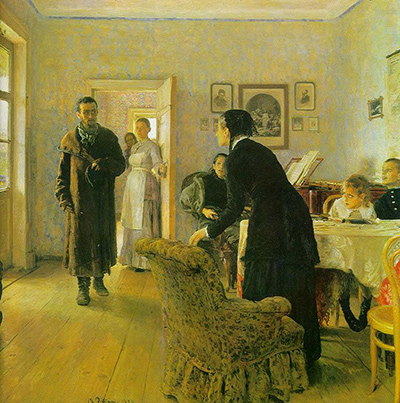They Did Not Expect Him is the dramatic and emotional homecoming of an Unexpected Visitor, the alternative title of this piece. Ilya Repin's amazing scene dates from around 1883 and was painted as an oil on canvas.
The original painting measures 160.5cm by 167.5cm and now hangs in the Tretiakov Gallery in Moscow, Russia. This painting was the final one of a series which focused on the Russian Revolution. He used his own living room, wife, mother-in-law and daughter as models in the piece. The sunlight pouring through the windows and bouncing off the back wall provides the daytime setting for the image. It importantly sets the tone of the piece along with the colours which he used - the yellows, blues and browns, suggesting that this will be a happy and joyous event.
Rather like a still from a movie scene, a maid opens the door to the living room, her hand remains on the door handle. She appears concerned, waiting to see the response to the unexpected visitor. A second person, probably the cook, curiously peers over the maid's shoulder. A slightly disheveled man steps across the floorboards, clutching his cap. He is wearing and scarf and a long woollen coat with sleeves that are much too long. His boots seem well worn and this, along with his thin beard and gaunt face, gives him a more weary look. The figure seems slightly hesitant, and his eyes are apprehensive, he is unsure what to expect.
To the front of the painting, an old woman dressed in black, rises from her chair. We cannot see her full face or expression but she leaves her hand on the chair to steady herself, she appears both old and shocked as she slowly moves to greet her son. Two children are seated at the table. The younger girl stops working on her books and studies the unexpected visitor with apprehension and puzzlement. She does not seem to recognize the visitor. Her shoulders are slightly hunched, she is unsure what is happening. In stark contrast the older boy, her brother, breaks into a huge smile, his eyes filled with joy as he recognizes his father. The woman at the piano has stopped playing and turns to stare at the visitor, she is hardly able to believe her eyes as she realizes that her husband has returned from his long and hard political exile in Siberia. They Did Not Expect Him.
Repin's painting is a clever composition. He places both the mother and the main character off centre with the floorboard running back to the maid at the door, drawing the viewer's attention to the characters and adding emotional impact. What is perhaps the most engaging aspect of the painting is the expressions and eye contact between the characters. Repin was reported to have redrawn his main character four times before he was satisfied with expression portrayed. There are similarities to the work of fellow realist, Gustave Caillebotte.
Repin had already completed a version of this painting using a female as his main character, that painting was much smaller and less complex. This painting is rich with detail causing the viewer to search the image for clues, from the characters portrayed, to the type of room, the furnishings and the photographs on the wall. These clues suggest that the family were part of the "intelligentsia". This particular painting was studied intensively by Russian psychologist Alfred Yarbus who used a device to map and track visual behavior of viewers. He discovered that rather than focus on the areas with the most detail, viewers of the painting were more interested in the details that helped to decipher the meaning of the painting. He found that vision darted from expression to expression searching for information. They Did Not Expect Him is a wonderful picture capturing a huge range of human emotion and expression in just one frame.




